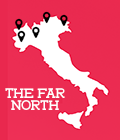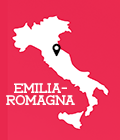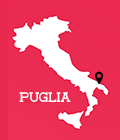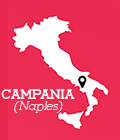It’s a country the size of Arizona that wasn’t even a country until 1861, and yet the foods of Italy have captured the imagination and palates of the world like few others. That’s especially true here in the country of Long Island, where no less than a quarter of the population claims Italian heritage, a pizzeria exists around every corner, and almost no aspect of the Boot’s great bounty—from Piedmont to Sicily—is ignored. Here, then, is a celebration of Long Island’s favorite cuisine, and a true buongustaio’s guide to the best of the best.
ESPRESSO YOURSELF: Tossing back an espresso at a counter or bar is a quintessential experience across Italy, where “bar” doubles as a place where you get coffee. In that country, cappuccino is only drunk in the morning and espresso or a macchiato, later in the day and through the evening. The ritual gained steam there beginning in the early 20th century, and eventually hatched the term “barista,” used to describe those who force boiling water through ground beans for inky, extra-strong coffee. While espresso culture is not as prevalent on Long Island, a few places still uphold the tradition. Out east, in Greenport, Aldo’s Coffee Company caffeinates the locals with beans roasted by owner Aldo Maiorana, a Sicilian native. His house-roasted Orient Espresso blend ($20/lb.) sets a local standard for powerful roasts, and the cafe’s buttery biscotti are the perfect accompaniment ($10 for a bag of 12). At Martoni Gourmet in Northport, you’ll find an intimate Italian grocery where Nino Carusone, a native of Campania, deftly maneuvers a La Spaziale espresso machine (and beans imported from Naples) for cups of hot espresso topped with crema, a touch of bronze froth. You never know who you’ll meet when lingering with your espresso, but you’ll probably hear both English and Italian spoken. Drinkers can also decamp into an adjacent café that holds a few tables and a gelato counter or snag a bistro table on the sidewalk.

Aldo Maiorana of Aldo's Coffee Company in Greenport roasts coffee inside the cafe. Credit: Randee Daddona
UNDERSTANDING OLIVE OIL: There are many countries that produce fantastic olive oils, but if you want an Italian one, check the label: It should state that the oil was produced, not just bottled, in Italy. The freshest oils you’ll find right now are from the 2021 harvest and have an expiration date of 2023 or 2024. We’re talking about extra-virgin olive oil here, the highest grade and, according to the International Olive Oil Council, must contain not more than .8 percent acidity and be cold-pressed—extracted, that is, by mechanical, not chemical means. Most Italian specialty stores and many supermarkets stock good Italian olive oils. Three other shops that are worth seeking out are Hen of the Woods (Southampton), Babylon Mercantile (Babylon) and Mill Road Cheese Shop (Westhampton Beach). Extra-virgin olive oils range from mild and fruity Ligurians to classic peppery Tuscans and are available at various prices; reserve that $30 bottle oil for salads, grilled fish, ripe tomatoes or fresh mozzarella.
STROLLING WITH GELATO: The experience of sauntering, cup or cone in hand, through a Renaissance or Baroque piazza is quintessentially Italian. Still, Long Island offers some charming gelato-adjacent strolls: Head west from Martoni Gourmet (Northport), along Main Street, to Cow Harbor Park. Southold General (Southold), has its own tiny piazza, Einstein Square. Dolce (Bellmore) is across Merrick Road from the charming Mill Pond Preserve. Another Italian tradition that should really become more popular here is sandwiching gelato in a brioche bun. But this classic Sicilian breakfast treat can be enjoyed at Spiga Bakery (Bellmore) and Caffe Italia (Deer Park).

Pistachio and chocolate gelato served on a soft brioche bun at Caffe Italia in Deer Park. Credit: Daniel Brennan
PORK STORES TAKE LONG ISLAND: The modern-day Italian American pork store has its roots in the Italian salumeria—a store that specializes in cured pork products—but in addition to carrying products such as salami and capocollo (a.k.a. capicola, coppa) you’ll also find house-made fresh sausages and mozzarella, imported tomatoes, Moka stove-top espresso makers and much more. Local pork stores that have expanded into minichains include Gemelli (Babylon, Glen Head) and Iavarone Bros. (est. in Brooklyn in 1927), now with specialty markets in Woodbury, Wantagh, New Hyde Park and Maspeth. The A&S pork stores in Franklin Square, Oceanside, Merrick, Massapequa, Huntington Station and East Islip don’t share ownership but descend from the original A&S founded in 1948 in Brooklyn by Anthony Scicchitano. One young sausagemaker who worked there was Andrea Ceriello, of Ceriello Fine Foods in Williston Park. He’s also a partner at Licini Brothers, a wholesale salumeria in Union City, New Jersey. What many consider to be the Island’s greatest pork store is Razzano’s in Glen Cove, an Italian American enclave for more than 100 years. Five years after Agostino Razzano opened it in 1963, Vincent Condello, newly arrived from Calabria, took over and has presided over this palace of gustatory wonders ever since. As Italian Americans moved eastward to Suffolk, they were accompanied by pork stores, and fine ones in that county include Mr. Sausage in Huntington, Frank & Maria’s in Bay Shore, Delfiore in Patchogue, Del Fiore in Rocky Point and Scotto’s in Hampton Bays.
The Far North of Italy encompasses the regions that do not jut into the Mediterranean, and their cuisines and cultures often blend with the countries they border. Piedmont, Valle d’Aosta, Lombardy, Trentino-Alto Adige and Friuli Venezia Giulia share long frontiers with, west to east, France, Switzerland, Austria and Slovenia.
Much of this terrain is Alpine, which is why you’ll find Italian food and wine at Alpina in Greenport. The restaurant is owned by Christoph Mueller, proud son of Switzerland. Chef George Musho said that much of his inspiration came from Ticino, the Italian-speaking southernmost canton that shares Lago Maggiore with Italy. Musho serves a beef tartare made with meat from the prized ancient Piedmontese breed.
In addition to little-seen Swiss vintages, Alpina’s wine list is a great introduction to the wines of the Piedmont. Grown in the foothills (the translation of “piedmont”), they include some of the world’s greatest, Barolo and Barbaresco; the most drinkable, Barbera and Dolcetto; and the sparklers Asti and Brachetto.

Piedmontese beef tartar at Alpina in Greenport. Credit: Yvonne Albinowski
Piedmont’s neighbor to the east, Lombardy, also raises cattle, though mostly for dairy; Gorgonzola and Taleggio are two of the most famous cheeses produced there. Lombardy gives us veal Milanese, and also osso buco (Italian for “bone with a hole”). The term refers to veal shank crosscut to expose the marrow bone, so its contents enrich the liquid in which the meat is braised. (A whole braised shank, a fine dish in its own right, is called “stinco.”) Osso buco may be found in restaurants throughout Italy and the United States. It’s a frequent special at Piccolo Mondo in Huntington where, said owner Roland Mizaku, it is typically served with gremolata, a sauce of parsley, garlic and lemon.
The most traditional accompaniment to osso buco is risotto Milanese, tinted golden with threads of saffron. In addition to dairy cattle, the well-watered plains of Lombardy are ideal for growing rice, particularly the plump, high-starch Arborio and Carnaroli varieties that lend risotto its characteristic creaminess.

Veal osso buco topped with gremolata and served on a bed of risotto at Piccolo Mondo in Huntington. Credit: Yvonne Albinowski
The easternmost region of Italy is Friuli Venezia Giulia. Istria, the peninsula that once marked its eastern border, was part of Italy until 1946 (long story short, it’s now part of Croatia) and has been a fertile source of Italian American restaurateurs including Lidia Bastianich and the owners of Giulio Cesare Ristorante in Westbury and Dario’s in Rockville Centre. The distinctive Istrian pasta, fuzi, made from rolled-up diamonds of fresh pasta (like garganelli, but without the ridges), is a rarity on Long Island but you’ll find it at Konoba, the Mediterranean-Croatian restaurant in Huntington.
SHOP: Travel through Piedmont, and you’ll find crisp grissini, Italian breadsticks on every restaurant table. Found at pork stores, Italian markets and supermarkets all over Long Island, they’re an inexpensive way to elevate an everyday meal. Gorgonzola, named for a town outside Milan, is a blue-veined cows’-milk cheese sold two ways: the dolce (“sweet”) version is milder and creamier than naturale (a.k.a. picante), which is aged and more assertive. Available at pork stores and specialty markets such as The Village Cheese Shop (105 Love Lane, Mattituck; 631-298-8556; thevillagecheeseshop.com).
Restaurant information
ALPINA: 45 Front St., Greenport; 631-477-2600, alpinany.com
DARIO’S: 13 N. Village Ave., Rockville Centre; 516-255-0535
GIULIO CESARE RISTORANTE: 18 Ellison Ave., Westbury; 516-334-2982, giuliocesareristorante.com
KONOBA: 46 Gerard St., Huntington; 631-824-7712, konobahuntington.com
PICCOLO MONDO: 1870 E. Jericho Tpke., Huntington; 631-462-0718, piccolomondoli.com
If Italy’s landscape is akin to a fairy tale, Liguria might be its visual zenith. It’s a storybook land of quaint fishing villages and medieval architecture hugging turquoise coves. Curving along more than 200 miles of the Mediterranean Sea in Italy’s northwest corner, it shares laid-back vibes with its neighbor, the South of France. It is also where some of the most emblematic Italian dishes have been perfected.
Grinding basil into pesto, for instance, is a practice rooted in ancient Rome and honed in the kitchens of Liguria’s capital, Genoa, where the silky result is known as pesto alla Genovese. Pesto as we know it in the States—a pulverized blend of basil, garlic, pine nuts, extra-virgin olive oil and hard cheeses, usually Parmesan and pecorino—debuted in the middle of the 19th century, and Genoa has been at its core ever since. At Mangia Bene in Rockville Centre, fresh strozzapreti (“priest stranglers”) pasta is given the full treatment—that is, tumbled with green beans and diced potatoes for a supple, garlicky plate of comfort.
The flatbread known as focaccia, too, has been perfected by the Ligurians, who eat it as street food. Crisp on the outside, airy on the inside and suffused with olive oil, focaccia traces its roots back to the Etruscans and has been baked and consumed from Roman times—when it was used as a dipping bread—until now. In Liguria, dimpled focaccia takes on myriad forms, from crunchy, salt-speckled focaccia alla Genovese to creamy, stracchino cheese–filled focaccia di Recco and focaccia con cipolle, topped with onions roasted to a crisp.

Tomato/basil and olive/onions focaccia bread at Spiga Bakery in Bellmore. Credit: Newsday/Alejandra Villa Loarca
The fingers of focaccia that come in many bread baskets on Long Island are often layered with roasted tomatoes, but sheets of focaccia can be tricky to track down in local bakeries. Among the exceptions are Spiga Bakery in Bellmore, where the kitchen bakes rounds of puffy focaccia a few times a week, from a billowy tomato-basil focaccia to another topped with olives and slivered onions for hits of savory sharpness.
At its essence, Liguria is a seafaring land, and fresh fish is at the top of the restaurant food chain. The Mediterranean teems with tuna, mackerel, whitebait, anchovies, sardines and shellfish, which are braised, poached, roasted, stewed, sautéed and deep-fried by the region’s chefs into dishes that exude lightness of being, often using wine, butter, herbs and broth.
At La Piccola Liguria in Port Washington, some of those Ligurian-inflected dishes—grilled sardines, for instance—lurk on the encyclopedic list of daily specials, recited tableside by a jacketed server. Yet Ligurian dishes crop up in subtle and singular ways on other menus, too, such as at Trattoria Diane in Roslyn, where scallops, shrimp and calamari are dusted with flour and flash-fried into a gossamer fritto misto, another street snack of Liguria. Both there and here, it comes with wedges of lemon and a shattering crunch.

Fritto misto with scallops, shrimp, and calamari at Trattoria Diane in Roslyn. Credit: Yvonne Albinowski
SHOP: In a perfect world, we’d all get our pesto fix at Mangia Bene or make our own and freeze to enjoy year-round. But just in case, keep some jarred pesto (brands to look for include Rustichella d’Abruzzo, DeLallo and Calvi) and dried pasta (the little tapered twirls called trofie are the classic form for pesto) from Liguria in the pantry, and you’ll be able to channel August whenever. Available at Razzano’s (286 Glen St., Glen Cove; 516-676-3745; razzanosny.com) and other pork stores as well as online sources.
Restaurant information
LA PICCOLA LIGURIA: 47 Shore Rd., Port Washington; 516-767-6490, la-piccola-liguria.edan.io
MANGIA BENE: 14 S. Park Ave., Rockville Centre; 516-447-6744, mangiabenervc.com
SPIGA BAKERY: 2680 Merrick Rd., Bellmore; 516-557-2688, spigabakery.com
TRATTORIA DIANE: 21 Bryant Ave., Roslyn; 516-621-2591, trattoriadiane.com
The aperitivo—a ritual of predinner drinks and snacks not unlike our own but with better drinks and no bowls of Chex Mix—is a cherished tradition all over Italy, although there is general agreement that Venice does it best, at least when there are no Milanese present. The Venetians take their cicchetti (bar snacks) very seriously, and among the most popular of these, beef Carpaccio, was even invented there in 1950 at Harry’s Bar. The meat, paper-thin shavings of bright red and white, looks like something you’d see in a painting by Carpacc—oh, right, that’s how it got its name.
Beef Carpaccio is available Island-wide, but for the closest approximation of an aperitivo experience, head to Casarecce Italian, a new Bellmore spot where owner Alex Fiorentino and chef Julius Miranda offer a broad selection of small bites and plates, including capocollo, soppressata, creamy Gorgonzola dolce (a great gateway blue cheese for the uninitiated), and buttery Carpaccio, all of them accessorized by grilled breads, house-made fig jam, walnuts, olives and the like.
Casarecce’s beverage list is equally muscular, and that’s before you get to the build-your-own-negroni section, in which tipplers apply a five-point scale to three separate parameters (for example, herbal-spicy). For the record, we heartily endorse 1-5-5, but the mathematical and bespoke possibilities are endless.
The floating city is also devoted to polenta, Venetians having seen a great deal of potential in what is basically cornmeal mush. Enrichments include cheese and butter, and it’s served in every possible configuration and consistency, from a soft, molten slurry spooned out of the pot to sweet or savory cakes.

Insalata di spinaci e balsamico at Cassariano in Mineola. Credit: Newsday/Alejandra Villa Loarca
Given that, it’s no surprise that polenta is featured on many a Long Island menu, including that of Cassariano in Mineola, which proudly serves a cheesy cake of polenta Valdostana that arrives oozing with Fontina and drizzled with truffle oil, salads enhanced by polenta “bites” (you may never go back to regular croutons again), a main course in which alternating planks of polenta and chicken breast are stacked on top of each other under a generous dousing of Gorgonzola sauce and more.
SHOP: Speck (basically, smoked prosciutto) has been made in the far northern region of Alto Adige [link to Far North region?] for centuries. Saltier and firmer than plain prosciutto—thus able to stand up to bigger flavors—the maroon slices edged with creamy white fat are a treasured component of the aperitivo tradition and available at pork stores and specialty markets. Aperol, a low-in-alcohol liqueur developed in 1919, includes bitter and sweet oranges, herbs and roots. It’s the key ingredient in an Aperol spritz, an aperitivo made with sparkling wine (and often sparkling water) that was created in the Veneto region in the 1950s. It’s available at wine shops.
Restaurant information
CASARECCE ITALIAN: 2620 Merrick Rd., Bellmore; 516-308-7224, casarecceitalian.com
CASSARIANO: 348 E. Jericho Tpke., Mineola; 516-280-8990, cassariano.crave.it
Enchantment clings to the hills of Tuscany, where the light has a mystical quality and mists settle at dusk and dissipate after dawn. The medieval villages that dot this landscape are ringed by pastures, olive groves, vineyards and forests where wild boars forage and truffles are hunted each fall.
The jewel in Tuscany’s crown is Florence, and dishes cooked in the ways of that city and its environs are dubbed “alla Fiorentina.” For bistecca alla Fiorentina, which is grilled over a coal or wood fire, Il Piccolo Villaggio in Islip uses a 20-ounce bone-in rib eye.
The Bistecca alla Fiorentina at Il Piccolo Villagio in Islip. Credit: Linda Rosier
Inside his cozy Franklin Square trattoria, Chef Gigi’s Place, Gigi Sacchetti (a native Florentine) serves truffles all year long; his house pappardelle with porcini mushrooms is bathed in a creamy black-truffle sauce that exudes the earthiness of a Tuscan valley. The perfect pairing is the quintessential wine of Tuscany: Chianti, which can reach high octaves of grace and complexity and is primarily produced from the sangiovese grape. Its high acidity brings each bite to life and cuts through cheese, pork, cream or any other rich flavor you put in its path.
Rustic elegance also shines through in the food of Umbria, just to the south. At Osteria Umbra in Smithtown, for instance, a dramatic wood fire roasts veal chops, poultry—and a whole suckling pig—but chef Marco Pellegrini also grinds sausage in his native Umbrian style for a warming lentil stew. This is also the rare restaurant where you can try one of Italy’s most prized red blends, a super Tuscan, without draining your wallet. Osteria Umbra pours a roster of super Tuscans by the glass, as well as sangiovese-based Brunello di Montalcino wines, with their haunting tangle of dark cherries, tobacco, licorice and loam.
The art of roasting pork, one that cuts across many cuisines, has arguably been perfected in central Italy, and its name is porchetta—a boned, whole suckling pig that is stuffed with garlic and wild fennel and other herbs, and rolled before being ever so slowly cooked. In Italy, it’s sliced with the crackling and stuffed into crusty rolls. A few thousand miles from the Umbrian countryside, Ceriello Fine Italian Foods in Williston Park imports Levoni porchetta for sandwiches; it’s sliced to almost translucent slices that melt in the mouth.
SHOP: Bartolini brown lentils, grown in southern Umbria by the Bartolini family since the 1850s, have rich flavor, a yielding texture and hold their shape after cooking. They’re available at pork stores and other Italian markets as well as online sources. Those are also the places to find wonderful artisanal pastas such as Giuseppe Cocco pappardelle. By special order, the butcher at Ceriello Fine Italian Foods (see above for details), will make you a fresh porchetta roast (a boneless loin wrapped with pork belly) for cooking at home. You may need a bottle of Chianti to go with that; look for Chianti Classico for the purest expression, and Riserva or Gran Selezione from this subregion for best in show.
Restaurant information
CERIELLO FINE FOODS: 541 Willis Ave., Williston Park; 516-747-0277, ceriellofinefoods.com
CHEF GIGI’S PLACE: 970 Hempstead Tpke., Franklin Square; 516-673-4630, chefgigisplace.com
IL PICCOLO VILLAGGIO: 260 Islip Ave., Islip; 631-650-0620, ilpiccolovillaggio.com
OSTERIA UMBRA: 197 Terry Rd., Smithtown; 631-780-6633, osteriaumbra.com
Emilia-Romagna, which sprawls from the northern Apennines in the west to the Adriatic Sea in the east, is Italy’s culinary epicenter. Elements of its cuisine—Parmigiano-Reggiano cheese, Prosciutto di Parma ham, balsamic vinegar, fresh pastas—have permeated many corners of the world, adapting to local tastes and ingredients. Take lasagna: Outside of Bologna (whether you’re in southern Italy or on Long Island), cooks usually substitute mozzarella and ricotta for the traditional béchamel sauce.
If you’re looking for the lasagna of Emilia-Romagna, you’ll want to visit The Trattoria in St. James. Chef-owner Stephen Gallagher sets a slab in an earthenware dish and bakes it until the satiny béchamel begins to brown. Long Island native Gallagher comes by his Bolognese bona fides by dint of study and travel. Robert Franceschini was born with his. The founder of Piccolo’s in Mineola is from Berceto, about an hour southwest of Parma. Robert Sr. has passed on most of the cooking to his son James, and the hand-cut ravioli is wrapped around one of about a dozen fillings.

Lasagna Bolognese with beef, pork and guanciale at The Trattoria in St. James. Credit: Yvonne Albinowski
It’s fair to say, though, the Island’s fullest-on Emilia-Romagna experience is at Osteria Morini at Roosevelt Field in Garden City. There you’ll find a classic tagliatelle with Bolognese ragù and cappelletti filled with truffled ricotta. Or you may decide to luxuriate in a meat and cheese board that not only features expertly sliced Prosciutto di Parma but also mortadella, studded with whole peppercorns, bits of pork fat and, often, pistachios. Morini’s board also features Parmesan and robiolina, a rich, delicately tangy fresh cheese from neighboring Lombardy, as well as the restaurant’s “lardo pesto,” made from grinding prosciutto fat with herbs, Calabrian chili and broth. To drink? Lambrusco, Emilia-Romagna’s most famous wine. In the 1960s, when Riunite introduced it to the United States, its reputation took a hit, but this red sparkler is dry, fruity and altogether delightful. Morini usually has at least two available by the glass or bottle.
SHOP: True Parmigiano-Reggiano, with its incomparable depth of flavor and crumbly texture, is made solely in Parma, Reggio Emilia, Modena, Mantua and Bologna using raw milk from cows raised there. The whey drained from the curds is fed to the pigs whose hind legs will be made into Prosciutto di Parma, which has a complex balance of sweetness and saltiness. Balsamic vinegars run the gamut from ultracheap options (which won’t bear a balsamic consortium seal) to Oro Aceto Balsamico Tradizionale ($249.99), made in Modena or Reggio Emilia and aged at least 12 years. Drizzle a fine aged balsamic over fresh fruit or shards of Parmesan. For salads, go with a balsamic in the $20 range. All above available at Iavarone Bros. (1538 Union Tpke., New Hyde Park, 516-488-5600; 1166 Wantagh Ave., Wantagh, 516-781-6400; 7929 Jericho Tpke., Woodbury, 516-921-5400; ibfoods.com)
Restaurant information
OSTERIA MORINI: 630 Old Country Rd., Garden City; 516-604-0870, osteriamorini.com
PICCOLO’S: 150 E. Jericho Tpke., Mineola; 516-248-8110, piccolosristorante.com
THE TRATTORIA: 532 North Country Rd., St. James; 631-584-3518, thetrattoriarestaurant.com
Despite having just experienced the worst day of his life, and despite being too poor to afford even the occasional evening out, Antonio Ricci decides to treat his young son Bruno to dinner in a Rome restaurant anyway. “There’s a cure for everything except death,” he says at one point during the scene from Vittorio De Sica’s “Bicycle Thieves,” that immortal classic of Italian neorealist cinema. It’s a heartbreaking moment, one that’s almost upstaged by the sight of Bruno’s disappointed face when he discovers there’s no pizza on the menu.
Thanks to Bruno, many have fallen in love with Roman-style pizza, pizza al metro, before they’ve even tried it, and the city’s celebrated take on that foodstuff remains a bucket-list favorite among travelers to Italy.
For Long Island metro mavens, the can’t-miss spot is Taglio in Mineola, where owner Rob Cervoni’s Rome-by-the-slice offerings range from spinach-and-artichoke to potato-and-rosemary, depending on the day.

Carciofi fritti with lemon aioli at Stellina Ristorante in Oyster Bay. Credit: Yvonne Albinowski
The Piazza Navona, renowned for its Baroque architecture, is also where Julia Roberts ate gelato in “Eat Pray Love” and Philip Seymour Hoffman drove a candy-red Alfa into the middle of the square in “The Talented Mr. Ripley.” It’s also known for the artichoke vendors at Campo dei Fiori market. Romans have created notable ways of preparing artichokes, and one of them, carciofi alla giudia, has long been a draw at La Ginestra in Glen Cove, although the artichokes are pan-seared instead of deep-fried in the traditional manner. No matter: This food of the Roman Jewish ghetto has now become a symbol of Roman food at large, and at La Ginestra, it comes lightly seasoned with herbs and has a delicate crunch. For a taste of heaven fritto-style, head to Trattoria Diane in Roslyn or Stellina Ristorante, a new Oyster Bay spot where chef Fabrizio Facchini fries artichokes to crisp perfection (see page 10).
Spaghetti carbonara played a role in making Jack Nicholson fall head over heels for Meryl Streep in the ’80s flick “Heartburn,” after Meryl whipped up a bowl of it in a jiffy and served it to him in bed. That said, there are at least a few carbonaras on the Island worth leaving home for. The aforementioned Trattoria Diane executes a satisfying take with a dice of peppery pancetta. And over in Rockville Centre, Mangia Bene creates a carbonara as soul-stirring as the dining room is cozy, a warmly lit and romantic space that almost guarantees a Hollywood ending.

Bucatini carbonara at Mangia Bene in Rockville Centre. Credit: Newsday/Alejandra Villa Loarca
SHOP: To make spaghetti alla carbonara or an Amatriciana sauce quintessentially Roman, try using guanciale (“gwan-cha-leh”)—that is, cured (not smoked) pork jowl, or, to put it in a more refined way, pig cheek. Guanciale is similar in flavor to pancetta but has a higher proportion of fat that enriches everything it is cooked with. Available at pork stores (see page 45), including Ceriello Fine Foods (541 Willis Ave., Williston Park; 516-747-0277; ceriellofinefoods.com).
Restaurant information
LA GINESTRA: 50 Forest Ave., Glen Cove; 516-674-2244, laginestrany.com
MANGIA BENE: 14 S. Park Ave., Rockville Centre; 516-447-6744, mangiabenervc.com
STELLINA RISTORANTE: 76 South St., Oyster Bay; 516-757-4989, stellinany.com
TAGLIO: 85 Mineola Blvd., Mineola; 516-741-0379, tagliopizzany.com
TRATTORIA DIANE: 21 Bryant Ave., Roslyn; 516-621-2591, trattoriadiane.com
Puglia occupies the heel of Italy’s boot, with long coasts along both the Adriatic and Ionian seas. It’s a seafood lover’s paradise but, inland, it’s intensely agricultural, providing wheat, tomatoes, grapes, almonds and more olive oil than is produced in any other region. The cuisine, said Lino DeVivo, is humble. The chef-owner of La Nonna Bella in Garden City grew up in Conversano, about 20 miles southeast of the capital city, Bari. In truth, he feels that some of the fare is too plain for his restaurant’s menu, but he has devised ways to gussy it up.

Burrata with capocollo at La Nonna Bella in Garden City. Credit: Yvonne Albinowski
Fave e cicoria, for example, is unlikely to get customers’ hearts racing, but this purée of split dried fava beans served alongside braised wild chicory (dandelion) is a beloved side dish in Puglia. At the restaurant, DeVivo turns the duo into a composed starter, mixing the greens into the purée, spooning them into a basket of dried bread and topping the package with fried onions.
Even Puglia’s most famous export has a modest backstory: Burrata (“buttered”) was developed as a way to use up day-old mozzarella. DeVivo explained that because mozzarella could not be sold the day after it was made, dairymen would tear it into bits and mix with the buttery cream skimmed from milk. This mixture would then be tucked inside a fresh ball of mozzarella to make burrata. On yearly trips to visit family, DeVivo enjoys fresh burrata with the superb capocollo (a.k.a. capicola, coppa) from Martina Franca, Puglia’s jewel of a Baroque city. Back in Garden City, he does a fine job with domestic capocollo.
About 10 miles southeast of Martina Franca is Alberbello, which boasts the largest concentration of trulli, the distinctive Pugliese dwellings, each topped with a conical stone roof. You can see models and photos of trulli at Trullo d’Oro, Gino and Maria Giannuzzi’s seven-year-old Hicksville charmer. You can also enjoy two great regional pastas, hybrid shapes that are made by hand like the fresh pastas of the north, but from hard semolina wheat and no eggs, like the macaroni of the south. Orecchiette (“little ears”) are served here with meatballs. Larger, more elongated strascinate come with the very traditional Pugliese duo of broccoli rabe and sausage.
You may want to start your meal, however, with the panzerottini, diminutive fried calzones stuffed with mozzarella and tomato. And accompany it with Primitivo, the great, big red of Puglia made with a relative of the zinfandel grape.
SHOP: As the dinner hour approaches, you might need a handful of taralli to stave off hunger pangs. These small, ring-shaped snacks get their addictive crunchiness from an olive oil dough that is usually twice-cooked. You’ll find them among the other snacks at pork stores, Italian markets and more than a few supermarkets. You also might want to pick up a few bottles (or a case) of Primitivo at your local wine shop. This rustic, full-bodied red is delicious with sausage and peppers, for instance, or the first grilled meats of the season. The grapes for Puglia’s signature wine ripen under the hot Italian sun, so the result is typically less sweet and fruity than its California counterpart, zinfandel. Like a California zin, though, Primitivo is available at various price points.
Restaurant information
LA NONNA BELLA: 660 Franklin Ave., Garden City; 516-248-0366, lanonnabella.com
TRULLO D’ORO: 294 N. Broadway, Hicksville; 516-719-0070, trullo-doro.com
Campania is a study in contrasts, comprising Mount Vesuvius and the Amalfi Coast, the traffic-clogged alleys of Naples, vast olive groves and a jaw-dropping coastline. It’s also the ancestral home of many Long Islanders. When legions of Italians migrated to the East Coast of the United States in the late 19th century, Neapolitans brought with them unmatched masonry skills as well as something that would alter American culture forever: pizza.
The beloved flatbread began its epic run almost half a millennium ago as a Renaissance-era Naples street food. Fast-forward to 1889, when it’s thought that Neapolitan pizzaiolo (pizzamaker) Raffaele Esposito created Margherita pizza in 1889 in honor of Margherita, queen consort of Italy, upon her visit to Naples. The colors of the pizza—green (basil), red (tomatoes) and white (mozzarella)—on what would become the most iconic of pizzas were said to allude to the new Italian flag.
Naples’ dominion over all things pizza has resulted in it being protected by the European Union, and strict standards now govern the city’s puffy-rimmed, thin-crust style of pie, including the type of flour used for the dough (type ‘0’ or ‘00’ from grain grown and milled in Italy) and the tomatoes (San Marzano, grown in the mineral-rich volcanic soil around Vesuvius). In the United States, the great Italian migration deposited pockets of sublime pizza in various parts of the Northeast, including across Long Island.

Owner Gianluca Chiarolanza at Naples Street Food in Oceanside. Credit: Linda Rosier
At Naples Street Food in Oceanside, the Italian-born owner and pizzaiolo Gianluca Chiarolanza turns out characteristic Neapolitan-style pizza. The Borgo, for instance, is rich with smoked mozzarella, the bitter slap of broccoli rabe, and diced Prosciutto di Parma. (This homey restaurant also plates a hearty lineup of panozzi, or flat heroes). And gracing almost every Italian menu from the Queens line to the tip of each fork, insalata Caprese (which purportedly originated on the island of Capri, just off the Amalfi Coast) is ubiquitous. It’s at its showiest with wobbly-fresh mozzarella and summer’s tomatoes.
It’s frutti di mare, however, that has sustained many Campanians for centuries. Octopus stewed with tomatoes and garlic. Fried squid and potatoes. And clams, so many clams, including clams Posillipo (possibly named for the Posillipo neighborhood of Naples). It was a favorite of Frank Sinatra, who might also have made time for the mussels Posillipo at Casa di Fratelli in Westbury. There, the cozze are arranged in puddle of tomato broth, sprinkled with herbs and splashed with wine. Are those whole cloves of garlic? Yes, they are, adding their pungent wallop to a broth that stands in a class of its own.

Mussels posillipo are arranged in a puddle of tomato broth, dusted with herbs and splashed with wine at Casa Di Fratelli in Westbury. Credit: Yvonne Albinowski
SHOP: You’ll find good house-made mozzarella at pork stores and Italian markets all over Long Island, but the balls of mozz at Mr. Sausage (3 Union Place, Huntington; 631-271-3836; mrsausagefinefoods.com) are perfection and made twice a day. You’ll also find creamy bufala mozzarella, made in Campania and air-shipped a day later. If you want intensely flavored San Marzano tomatoes from their home soil, look for a brand such as Gustarosso DOP San Marzano tomatoes, produced by a cooperative of about 100 farmers in the Agro Sarnese Nocerino, south of Naples.
Restaurant information
CASA DI FRATELLI: 477 Old Country Rd., Westbury; 516-385-3700, casadifratelli.com
NAPLES STREET FOOD: 2905 Long Beach Rd., Oceanside; 516-442-1692, naplesstreetfoodoceanside.com
Sicilians represented a large percentage of Italians who came here at the turn of the 20th century, soon acclimating themselves to the point that it’s impossible to imagine life today without their contributions to Long Island culture—not to mention the construction of infrastructural necessities like the LIE and LIRR.
Dishes of Sicilian provenance are legion on the Island and are among the most interesting and delicious in all of Italian cooking. That island was a cultural crossroads for millennia, and Arab, Greek, Spanish and North African culinary influences remain. Take pasta con le sarde, the hands-down favorite pasta dish of many. The recipe at Vespa Italian Kitchen & Bar in Farmingdale is straight out of Castellammare del Golfo, west of Palermo and where co-owner Ben LoManto was born. The fresh fish, which is minced, accents rather than dominates the dish, which swings sweet-savory with fennel, pine nuts, raisins, roasted cauliflower and, last but not least, bucatini.
Pasta con le sarde at Vespa Italian Kitchen & Bar in Farmingdale. Credit: Linda Rosier
At Insatiable Eats, Marco Barilla’s Riverhead restaurant/pasta laboratory/gourmet market, the chef, who grew up in the northeastern Sicilian city of Messina, delivers specialties that include braciole di pesce spada, in which slivers of swordfish are combined with breadcrumbs and herbs, rolled into cylinders and lined up on a skewer. It’s served over a bright salad of fennel, arugula and orange, a Sicilian classic that would be right at home in Morocco.

Braciole di pesce spada at Insatiable Eats in Riverhead. Credit: Yvonne Albinowski
No Sicilian dish has had a greater impact on Long Island’s culinary imagination, or waistline, for that matter, than arancini (rice balls). Those at Vincent’s Clam Bar in Carle Place are splendid—golden, luscious orbs of Arborio rice stuffed with herbs and a blend of cheeses, dusted in breadcrumbs, and fried with restraint.
SHOP: The jarred or canned eggplant and olive salad/relish/condiment called caponata, with its rich consistency and color, will make you fall in love with Sicilian food. It’s believed to have been created as a seafaring provision, as the vinegar in it acts as a preservative. A true convenience food, you’ll want to make it a pantry staple: Add it to an antipasto platter or serve with bruschetta or crostini. Available at pork stores and Italian specialty markets as well as many supermarkets.
Restaurant information
INSATIABLE EATS: 300 E. Main St., Riverhead; 631-377-3353, insatiableeats.com
VESPA ITALIAN KITCHEN & BAR: 282 Main St., Farmingdale; 516-586-8542, vespaitaliankitchen.com
VINCENT’S CLAM BAR: 179 Old Country Rd., Carle Place; 516-742-4577, vincentsclambar.com



























